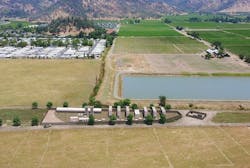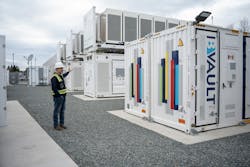Triple-Tasking Calistoga Microgrid to Participate in CAISO Market, Lowering Resiliency Costs
Pacific Gas & Electric’s (PG&E) efforts to cope with its wildfire woes and the public safety power shutoffs (PSPS) associated with them have spurred the development of an innovative microgrid, the Calistoga Resiliency Center.
The project–developed by Energy Vault–is expected to be up and running by Sept. 1, providing resilience for the outage-prone town of Calistoga, cutting diesel use during PSPS and lowering resilience costs by participating in the California Independent System Operator (CAISO) market.
On July 24, the project passed a final hurdle, with the California Public Utilities Commission (CPUC) approving amendments to microgrid developer Energy Vault’s energy service contract with PG&E, allowing Energy Vault to pursue participation in the CAISO market.
Under the contract, PG&E will pay Energy Vault monthly for providing the power for the town, said Marco Terruzzin, chief revenue officer at Energy Vault.
Lowering diesel use during PSPS
The microrid’s evolution dates back to September 2021, when PG&E brought together numerous stakeholders to discuss how the utility could lower diesel use while keeping the lights on in certain areas during fire emergencies and PSPS.
Microgrids and distributed energy resources (DERs) can meet this goal, stakeholders said.
More recently, the CPUC called for the state’s utilities to deploy clean microgrids at substations to help solve the PSPS challenge.
On Jan. 21, 2021, the CPUC issued an order, that laid out guidelines for utilities that reserve diesel generators to provide resilience during PSPS events. The CPUC asked utilities to begin moving toward clean generation, and required utilities that reserve temporary diesel generators to pursue at least one clean microgrid at a substation.
PG&E issued a request for proposals for a clean substation-level microgrid in Calistoga, and Energy Vault was awarded the contract. Energy Vault will own and operate the microgrid and provide that power to Calistoga’s outage-prone residents during PSPS, said Craig Horne, senior vice president, advanced energy solutions, Energy Vault.
Avoiding diesel generator use during outages
The microgrid will replace diesel generators that PG&E has been bringing to Calistoga during fire season, he said.
The Calistoga Resiliency Center will provide backup to 1,600 PG&E customers in the town for 48 hours during PSPS–delivering up to 8.5 MW of peak power and 293 MWh of energy capacity. As the first clean energy microgrid in the PG&E substation microgrid program, the project is expected to yield lessons for other utilities struggling to deploy clean energy during PSPS events.
An unusual characteristic of the project is the plan to participate in CAISO markets and also provide power during PSPS events.
Participating in markets boosts a microgrid’s economic viability. Microgrids can earn revenue by offering their power for day-ahead and real-time markets. They can also provide ancillary services to the central grid, including frequency control and spinning reserve.
Can the microgrid’s batteries serve two functions?
The state’s public advocate objected to the plan, saying that the microgrid might not be able to serve both Calistoga and participate in CAISO markets if, for example, the battery were depleted. PG&E argued that Energy Vault faces penalties if it fails to provide the promised backup power to Calistoga during PSPS, Horne said.
“With battery energy storage within the facility, we can do the second use case, grid services, and get revenues from the same equipment we use for backup, creating a secondary revenue stream that reduces the cost of providing resilience,” said Horne.
The Calistoga Resiliency Center’s output will be less expensive than using diesel “by a factor of two,” Terruzzin said.
Fuel cells and batteries to provide efficiency
During most of a PSPS, the Calistoga Resiliency Center’s fuel cells are expected to carry the load. The batteries’ role is for black starting the microgrid after a PSPS event. The batteries will also make the fuel cells more efficient, Horne said.
He compared the fuel cell/battery combination’s efficiency improvements to those of a plug-in hybrid vehicle’s improved efficiency.
“This allows fuel to go farther, like a plug-in hybrid,” he said. “This kind of backup system is competitive with traditional diesel generation, not only because we can get market revenues. This is a way to have a state of readiness for backup with a fuel cell.”
In the U.S. and abroad, utilities are facing outages, and not just during fire season, Horne said. This demonstration should inform other outage-prone regions about the potential to use clean microgrids during power emergencies.
PG&E, which attracted blowback for some of its other efforts to address PSPS, drew praise from Horne for this project.
“The Calistoga Resiliency Center is a precursor to what will hopefully become the norm--microgrids based on clean energy that not only provide power during a grid outage but which also support the larger grid during normal blue sky conditions," Peter Asmus, adjunct faculty, microgrid strategy and thought leadership at Alaska Center for Energy and Power, said.
About the Author
Lisa Cohn
Contributing Editor
I focus on the West Coast and Midwest. Email me at [email protected]
I’ve been writing about energy for more than 20 years, and my stories have appeared in EnergyBiz, SNL Financial, Mother Earth News, Natural Home Magazine, Horizon Air Magazine, Oregon Business, Open Spaces, the Portland Tribune, The Oregonian, Renewable Energy World, Windpower Monthly and other publications. I’m also a former stringer for the Platts/McGraw-Hill energy publications. I began my career covering energy and environment for The Cape Cod Times, where Elisa Wood also was a reporter. I’ve received numerous writing awards from national, regional and local organizations, including Pacific Northwest Writers Association, Willamette Writers, Associated Oregon Industries, and the Voice of Youth Advocates. I first became interested in energy as a student at Wesleyan University, Middletown, Connecticut, where I helped design and build a solar house.
Twitter: @LisaECohn
Linkedin: LisaEllenCohn
Facebook: Energy Efficiency Markets


